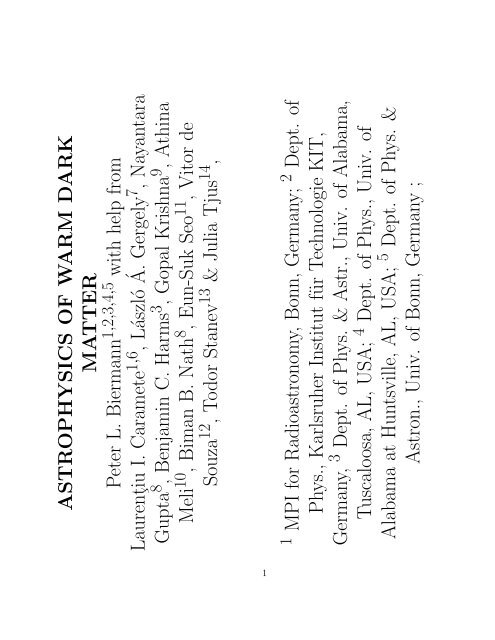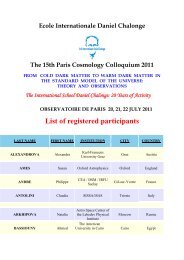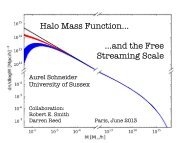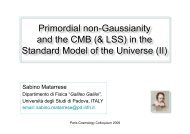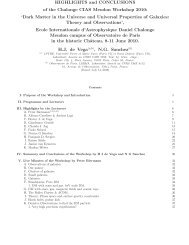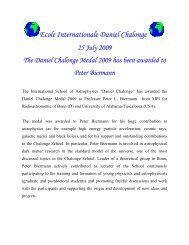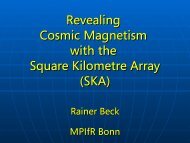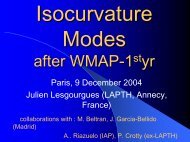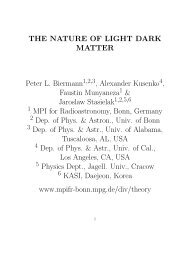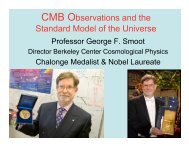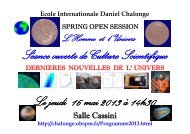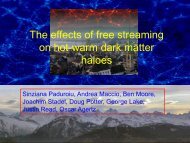You also want an ePaper? Increase the reach of your titles
YUMPU automatically turns print PDFs into web optimized ePapers that Google loves.
ASTROPHYSICS OF WARM DARK<br />
MATTER<br />
<strong>Peter</strong> L. Biermann1,2,3,4,5 with help from<br />
Laurent¸iu I. Caramete1,6 , László Á. Gergely7 , Nayantara<br />
Gupta8 , Benjamin C. Harms3 , Gopal Krishna9 , Athina<br />
Meli10 , Biman B. Nath8 , Eun-Suk Seo11 , Vitor de<br />
Souza12 , Todor Stanev13 & Julia Tjus14 ,<br />
1<br />
1 MPI for Radioastronomy, Bonn, Germany; 2 Dept. of<br />
Phys., Karlsruher Institut für Technologie KIT,<br />
Germany, 3 Dept. of Phys. & Astr., Univ. of Alabama,<br />
Tuscaloosa, AL, USA; 4 Dept. of Phys., Univ. of<br />
Alabama at Huntsville, AL, USA; 5 Dept. of Phys. &<br />
Astron., Univ. of Bonn, Germany ;
6 Institute for Space Sciences, Bucharest, Romania; 7<br />
Department of Theoretical Physics, University of Szeged,<br />
Szeged, Hungary; 8 Raman Research Institute,<br />
Bangalore, India; 9 NCRA, Tata Institute, Pune, India;<br />
10 University of Gent, Gent, Belgium; 11 Dept. of<br />
Physics, Univ. of Maryland, College Park, MD, USA; 12<br />
Universidade de São Paulo, Instituto de Física de São<br />
Carlos, Brazil; 13 Bartol Research Inst., Univ. of<br />
Delaware, Newark, DE, USA14 Dept. of Phys., Univ.<br />
Bochum, Bochum, Germany;<br />
2
AMS positron fraction: data 2013<br />
3<br />
Figure 1 AMS energetic positron fraction; source AMS-Coll. (2013) PRL. To quote: ”These observations show<br />
the existence of new physical phenomena, whether from a particle physics or an astrophysical origin.“
AMS positron fraction 2013: explanation?<br />
• Dark matter decay? Beautiful candidate!<br />
• Nearby special source? Pulsars?<br />
• Cosmic ray physics? CR-positron fraction should show<br />
a gradual decay (Protheroe 1982)<br />
• Spallation along the way, so interaction and transport<br />
coupled? Spallation near source?<br />
• Consider magnetic field structure in wind of very massive<br />
stars, Maxwell laws in magnetic stellar wind; Parker<br />
(1958): Polar cap component at source E−2 : upturn of<br />
all CR spectra (1993: 2009+); interaction stronger in<br />
polar cap region, so more secondaries, so in spectrum<br />
secondaries shifted to lower energy, giving a E +1/3 prediction<br />
for positron fraction leveling off to a constant.<br />
4
CR positron fraction: prediction 2009 - match<br />
E 0.32<br />
AMS02<br />
10 -1<br />
Fraction of positrons in AMS02<br />
5<br />
10 3<br />
10 2<br />
10 1<br />
10 0<br />
E, GeV<br />
Figure 2 Fitting our 2009 prediction, with power law 0.014 ± 0.019 off the predicted slope of 1/3 without using<br />
any zero-point; original source Biermann et al. (2009) PRL. At low energy matches Protheroe prediction, at<br />
high energy there is an indication of the expected leveling off.
The universe: Planck 2013<br />
Planck 2013 XVI (Table 2 ff): Term “dark matter” due<br />
to Oort (1933)<br />
The sum of all Ωs very close to unity, critical density:<br />
“flat” geometry, like a perfect tabletop:<br />
ΩΛ = 0.692 ± 0.010<br />
Ωdm = 0.2582 ± 0.0047<br />
Ωb = 0.0482 ± 0.00076<br />
Ωk = 1 − ΩΛ − Ωdm − Ωb = −0.0005 ± 0.0066<br />
H0 = 67.8 ± 0.77 km/s/Mpc<br />
Assuming gradual re-ionization<br />
zre−ion,init > ∼ 20<br />
Thomson depth: τT = 0.092 ± 0.013<br />
The age of the universe:<br />
t0 = (13.798 ± 0.037) · 109 yr<br />
6<br />
80 years: what is dark matter?
Supersymmetry! Evidence?<br />
• Supersymmetric massive particles decay<br />
and might explain many observations<br />
• Upturn in CR-e + /CR-e− ratio and CR-e− in cosmic<br />
rays (Pamela, Fermi, ATIC, AMS)<br />
• Fermi haze/bubble; 511 keV + 130 GeV line: Galactic<br />
Center region synchrotron and IC<br />
7<br />
• Cygnus cocoon spectrum<br />
• WMAP + Planck haze spectra<br />
• IceCube high energy neutrino background
A massive star and its magnetic field<br />
8<br />
Figure 3 Magnetic field topology around a massive star in its wind: Graph following Parker 1958 ApJ; central<br />
graph NASA, Wolf Rayet star WR124: Remember Maxwell’s laws! Magnetic field radial in polar cap,<br />
Archimedean tangential over the rest, most of 4π. Gives CR-spectra of E−2 in polar cap, and E−7/3 for rest.
Cosmic ray knee: paper CR-IV, 1993<br />
9<br />
Figure 4 Spectral and chemical structure at the knee, CR-e− and CR-e + components?, to be shifted to high<br />
energy? Element groups are H, He, CNO, Ne-S, Cl-Mn, and Fe. Source: Stanev et al., paper CR-IV 1993
Planck, WMAP, Fermi haze/bubble, 511 keV<br />
• Polar cap CR-electron component: with diffusion<br />
E−7/3 , radio spectrum ν−2/3 • In GC region transition between diffusion dominance<br />
and loss dominance shifted to higher particle energy –<br />
smaller scale height: Reproduces flux, radial profile<br />
• Spectrum predicted: ν−2/3 , ν−1 , ν−3/2 : confirmed by<br />
Fermi haze (2010), consistent with Planck haze (2012),<br />
the IC component: flat in E2 γ F (Eγ)<br />
10<br />
• Fermi bubble: unstable galactic magnetic wind driven<br />
by CRs from non-steady star-formation?<br />
• Correct number of positrons for 511 keV emission: grammage<br />
for ISM-SN-CRs about 1 gm/cm2 , and for wind-<br />
SN-CRs about 10 gm/cm2 (Nath et al. MN Lett 2012)<br />
• PLB et al., ApJL 710, L53 (2010): Planck haze data!
130 GeV line interpreted ?<br />
• Recent claims that 130 GeV emission line in Galactic<br />
Center region, Su & Finkbeiner 1206.1616; Buckley &<br />
Hooper 1205.6811; Weniger 1204.2797; Bringmann et<br />
al. 1203.1312.<br />
• Decay of dark matter particle?<br />
• Work with Nayantara Gupta and Biman Nath (RRI,<br />
Bangalore)<br />
11<br />
• Consider CR-electron spectrum, flat in E 3 J(E)<br />
• Consider radiation field, Moskalenko et al. 2006, peaks<br />
at 1 µ and at 100 µ<br />
• Inverse Compton by these CR-electrons gives equivalent<br />
contributions, fully explaining the weak line: pair<br />
production gives narrow feature in IC!<br />
• Confirms that CR-electron spectra similar in GC region
KASCADE, KASCADE-Grande and Auger<br />
0.6<br />
2.0<br />
)<br />
-2<br />
-1.5<br />
eV<br />
-1.2<br />
-1<br />
2.4<br />
Sum<br />
sr<br />
-1<br />
s<br />
1.8<br />
-2<br />
He<br />
24<br />
10<br />
H<br />
Ne-S<br />
CNO<br />
x dN/dE (m<br />
3<br />
Fe<br />
E<br />
12<br />
Cl-Mn<br />
23<br />
10<br />
KASCADE QGSJet<br />
KASCADE Sibyll<br />
KASCADE Grande<br />
Auger<br />
20<br />
10<br />
E (eV/nucleus)<br />
19<br />
10<br />
18<br />
10<br />
17<br />
10<br />
16<br />
10<br />
15<br />
10<br />
Figure 5 KASCADE, KASCADE-Grande, and Auger data interpreted as arising from a combination of Galactic<br />
CRs plus galactic CRs from another active galaxy, shifted up in a relativistic kick (Gopal-Krishna et al. 2010<br />
ApJL; PLB & de Souza 2012 ApJ). The numbers give (model - data)/(experimental error): this suggests a<br />
good fit beyond the knee, and a single extragalactic source, only Cen A: contrary to the expectation since 1966<br />
(Greisen, Zatsepin, Kuzmin) there is no other extragalactic source population necessary.
Summary cosmic ray particles<br />
• Quantitative predictions from 1993: Tests since 2009<br />
• Occam’s razor simplicity: CR-I to IV (1993) model<br />
suffices to explain the 2009 - 2013 data<br />
• Polar cap CRs of exploding stars with magnetic<br />
winds : CR positron fraction, Galactic haze,<br />
511 keV line, γ-ray continuum and 130 GeV line<br />
• CR spectrum possibly explained with our Galaxy and<br />
radio galaxy Cen A<br />
13<br />
• Below GZK no other source population required<br />
by the data: magnetic horizon (Ryu et al.<br />
2008+)<br />
• Can be falsified: very different abundances? magnetic<br />
wind of our Galaxy (Everett et al. 2008)? Neutrinos ?
DM proposal: Heavy or light particles?<br />
• One alternative: right-handed neutrinos, interact<br />
only weakly with normal left-handed neutrinos in low<br />
mass range, of order a few keV (review Kusenko 2009)<br />
• 2010 supporting particle physics arguments using the<br />
see-saw mechanism (Kusenko et al., Lindner et al.)<br />
• Most important decay channel: active, normal, lefthanded<br />
neutrino and a photon; the photon has half the<br />
energy, and so can ionize matter. They are never in<br />
thermodynamic equilibrium, probably far sub-thermal<br />
14<br />
• From increased early ionization star formation possible<br />
from about redshift 80 (PLB & Kusenko<br />
2006; Stasielak et al. 2007; Loewenstein et al. 2009)<br />
• Consistent with same phase space density ρDM/σ3 DM<br />
(e.g. Hogan & Dalcanton 2000; de Vega & Sanchez<br />
2010 - 2013, Destri et al. 2012, de Vega et al. 2012)
The sky in black holes > ∼108 M⊙: colors are<br />
distance<br />
90 o<br />
0 o<br />
360 o<br />
15<br />
90 o<br />
Figure 6 The sky in black holes, > ∼ 108 M⊙: The color code corresponds to distance: Black, Blue, Green, Orange,<br />
Red for the redshifts intervals 0, 0.005, 0.01, 0.015, 0.02, 0.025, corresponding to distance intervals of 0, 60,<br />
120, 180, 240, and 300 million light-years: (–> Caramete & PLB 2011); coordinate system with Galactic plane<br />
across center, and Galactic center at the right edge
Integral BH mass fct starts at ∼ 3 10 6 M⊙<br />
2<br />
0<br />
2<br />
4<br />
LogΦMBHMpc 3 <br />
16<br />
6<br />
8<br />
5 6 7 8 9 10<br />
Log MBHMsol<br />
Figure 7 Integral mass function corrected for Hubble type sampling, 2928 objects, the slope of the lines is:<br />
red −2.0 fitting > 108 M⊙, and blue −1.0 fitting between 107 M⊙ and 108 M⊙. See Caramete & PLB, Astron.<br />
& Astroph. 521, id.A55 (2010); arXiv:0908.2764. This mass function suggests that black holes start near<br />
3 106 M⊙, possibly at redshift of order < ∼ 50, and grow by merging (see PLB & Kusenko 2006, PRL)
Massive and supermassive stars at very low<br />
abundances<br />
• Massive star formation from redshift 80?<br />
• Massive star HII region<br />
• Massive star explosions?<br />
• Hyper Nova Remnant (HNR)<br />
• Stellar mass black holes?<br />
17<br />
• Gamma Ray Bursts?<br />
• Gamma emission redshifted to soft X-rays<br />
• Time scale of a few seconds shifted to minute<br />
• Search strategy to detect extremely high-z GRBs?
How did these ∼ 3 10 6 M⊙ black holes start?<br />
• Stars form in a potential well defined by DM properties<br />
(Munyaneza & PLB 2005, 2006): weakly degenerate<br />
supermassive Fermion galaxy cores<br />
• Massive stars form first, helped by the first molecular<br />
Hydrogen (PLB & Kusenko 2006)<br />
• Supermassive stars form by agglomeration of massive<br />
stars (Sanders 1970, Portegies Zwart et al. 2004), only<br />
with zero heavy elements (Yungelson et al. 2008)<br />
18<br />
• Supermassive stars + HII regions + explosion remnants<br />
+ residual: Thomson depth<br />
• Supermassive stars turn unstable near ∼ 106 M⊙ (Appenzeller<br />
& Fricke 1972): Hypernova remnant (HNR)<br />
• These HNRs both emit non-thermal radio emission,<br />
but also provide additional Thomson absorption depth
Stellar agglomeration conditions<br />
• Massive stars form in groups<br />
• Mass available at most about 107 M⊙ from baryonic<br />
mass fraction, using total mass of 5 · 107 M⊙ in primordial<br />
galaxy (Gilmore et al. 2007)<br />
• Life time of massive stars about 2 · 106 years, independent<br />
of mass<br />
• Free-fall time in DM clump about 107.1 yrs, so from<br />
redshift ∼ 100 matter falls into these clumps<br />
19<br />
• Also, relaxation time scale must be about 3 crossing<br />
times or less, implying (Lightman & Shapiro 1978)<br />
about 300 or fewer stars<br />
• Instability sets in at 5 · 105 M⊙, and infall will enhance<br />
the mass of the final black hole<br />
• Therefore initial massive stars of order > ∼ 10 3 M⊙
Absorption line forest, excited by cosmic rays<br />
• These stars make magnetic fields, explode, and then<br />
make cosmic rays:<br />
• These cosmic rays excite characteristic transitions in<br />
massive gaseous shells of molecular surrounding the<br />
HNR<br />
• Absorption line forest: H2, H + 2 , H+ 3<br />
• Identify groups of lines, originating from specific HNRs,<br />
and in the beam-adding need to be able to identify each<br />
HNR separately<br />
20<br />
• In any beam of a telescope many such lines, so very<br />
high signal to noise required<br />
• If such lines confirmed, key signature for a) cosmic rays,<br />
and by inference b) magnetic fields - and all at a known<br />
redshift: line equivalent width − > mass scale
The radio background, Thomson depth I<br />
Super-massive stars form and explode, producing a radio<br />
remnant:<br />
(1)<br />
R ∼ 10 22.76 cm E 1/5<br />
57 z−3/5<br />
1.3 {∆t}15 2/5<br />
Magnetic fields and cosmic rays:<br />
B ≈ 10 −5.44 η 1/2<br />
B,−1 E1/5<br />
57 z9/10<br />
1.3 {∆t}−3/5<br />
15 Gauß<br />
21<br />
15 , (2)<br />
C ≈ 10 −6.9 ηCR,e,−1 E 2/5<br />
57 z9/5<br />
1.3 {∆t}−6/5<br />
Luminosity at radio wave-lengths:<br />
ergs −1 Hz −1 .<br />
(3)<br />
Lν = 10 29.82 η 0.80<br />
B,−1 η+1<br />
CR,e,−1 E1.32 57 z3.34 1.3 ν−0.60<br />
9.0
The radio background, Thomson depth II<br />
Radio background (detected: Fixsen et al., Kogut et al.,<br />
Seiffert et al. 2011):<br />
Fν ≈ 10 −19.8 NBH,0,0 η 0.80<br />
B,−1 η+1<br />
CR,e,−1 E1.32 57 z+0.84<br />
1.3<br />
ν −0.60<br />
9.0 ergs −1 Hz −1 cm −2 sr −1 . (4)<br />
Single sources (Condon et al. 2012: Sν < 60 nJy):<br />
22<br />
(5)<br />
Sν = 10 −31.2 η 0.80<br />
B,−1 η+1<br />
CR,e,−1 E1.32 57 z+1.34<br />
1.3<br />
ν −0.60<br />
9.0 erg cm −2 s −1 sr −1 Hz −1<br />
Angular size of remnant (so about 12 arc-sec):<br />
θ = 10 −4.2 E 1/5<br />
57 z−1/5<br />
1.3 rad (6)
The radio background, Thomson depth III<br />
Predicted neutrino flux - observed now (IceCube 2013,<br />
lecture by Whitehorn: match!).<br />
Fneutr = 10 −10.2 NBH,0,0 E57 ηCR,p,−1 fneutr,−1 z 0.5<br />
1.3<br />
erg cm −2 s −1 sr −1 , (7)<br />
Mass of shell in gas (Kormendy et al. 2010, 2011)<br />
23<br />
(8)<br />
57 z−3/5<br />
1.3<br />
M shell = 10 10.4 M⊙ E 3/5<br />
Thomson depth through remnant (detected 0.09):<br />
(9)<br />
τT h,Σ = 10 −1.6 NBH,0,0 E 3/5<br />
57 z+9/10<br />
1.3<br />
FIR back ground contribution (matches limit):<br />
FIR = 10 −6.0 erg cm −2 s −1 sr −1 NBH,0,0 MSMS,6.5 z −1<br />
1.3
The radio background, Thomson depth IV<br />
So tests:<br />
• Radio background – detected, match<br />
• Neutrino background – detected, match<br />
• Gamma background – limits obeyed<br />
• Source counts – limits obeyed<br />
24<br />
• Reionization – Thomson depth detected, matched<br />
• Bulge-less disk galaxies – detected, large population<br />
(Spitzer survey)<br />
• FIR background – limits matched<br />
• Spatial structure of ionization column – prediction<br />
• Molecular Hydrogen lines in absorption – prediction
Energy density from ∼ 3 106 M⊙ BH formation<br />
and mergers ?<br />
1<br />
2 NBH,0 MBH c 2 (1 + z⋆) 3 DE (10)<br />
using the numbers above yields a value very close to<br />
the energy density of dark energy 10−8.2 erg cm−3 , from<br />
H0 = 67.8±1.4 km s−1 Mpc−1 , and ΩΛ = 0.692±0.016<br />
(source: Planck 2013 XVI)<br />
25<br />
Source of energy background (Randall & Sundrum 1999):<br />
energy density constant from stimulated emission of gravitons<br />
(Biermann & Harms 2013). Just simple re-interpretation<br />
of Λ-term as energy injection on cosmological time scales?<br />
Λ = (4πG N) × (4ρ DE) ?
First GWs from ∼ 3 10 6 M⊙ BH formation ?<br />
26<br />
Figure 8 Upper limits to GW signals (M. Kramer 2011). First mergers of super-massive black holes could<br />
start near 10−3.5 Hz, and the first stellar black holes near 10 +2.5 Hz at high redshift; their lower frequency side<br />
spectrum would be a steep power-law, but their amplitude is uncertain. Any signal would be superposition. A<br />
signal from redshift < ∼ 80 would be invisible until PTAs get much more sensitive − > confirmation?
? ? Weakly Interacting Neutrino = WIN ? ?<br />
• Prediction: ISM-SNe, wind-SNe and Cen A<br />
account for cosmic rays (quantitative model from<br />
1993 +, applied 2009 - 2013)<br />
• Prediction: At redshift of order < ∼ 80 first<br />
massive star formation, energetic CR particles, GRBs<br />
and first BHs, supermassive BHs (starting near 3 106 M⊙),<br />
high luminosity GWs (observable by PTA ?)<br />
• Prediction: radio background, neutrino background,<br />
BH formation explosion remnant Thomson depth - all<br />
detected, match<br />
27<br />
• Prediction: Radio background structure with residual<br />
Thomson depth; reionization by SMS and explosion<br />
remnant; same structure in γ-ray, X-ray and FIR bg<br />
• Prediction: At redshift of order < ∼ 80 H + 3 , H+ 2 ,<br />
and H2 forest of absorption lines
1 Acknowledgements<br />
PLB would like to thank G. Bisnovatyi-Kogan, J. Blümer,<br />
R. Engel, T.K. Gaisser, G. Gilmore, A. Heger, G.P. Isar, P.<br />
Joshi, K.H. Kampert, A. Kusenko, N. Langer, M. Loewenstein,<br />
I.C. Mari¸s, S. Moiseenko, G. Pavalas, E. Salpeter,<br />
N. Sanchez, R. Sina, J. Stasielak, and H. de Vega, and<br />
many others for discussion of these topics.<br />
28
2 Abstract<br />
Dark matter has been first detected 1933 (Zwicky) and<br />
basically behaves like a non-EM-interacting gravitational<br />
gas of particles. Particle physics suggests with an elegant<br />
argument that there could be a lightest supersymmetric<br />
particle, which is a dark matter candidate, possibly visible<br />
via decay in odd properties of energetic particles and<br />
photons: Such discoveries were made: i) an upturn in the<br />
CR-positron fraction, ii) an upturn in the CR-electron<br />
spectrum, iii) a cosmic ray anisotropy in data from Tibet,<br />
SuperK, Milagro, and now with IceCube, iv) a flat radio<br />
emission component near the Galactic Center (WMAP<br />
haze), v) a corresponding IC component in gamma rays<br />
(Fermi haze and Fermi bubble), and a flat γ-spectrum at<br />
the Galactic Center (Fermi), vi.a) the 511 keV annihilation<br />
line also near the Galactic Center, via.b) a tentative<br />
29
detection of a 130 GeV emission line, vii) an upturn in the<br />
CR-spectra of all elements from Helium, with a hint of an<br />
upturn for Hydrogen, viii) a derivation of the interaction<br />
grammages separately for CR-protons and CR-heavy nuclei,<br />
and ix) the complete cosmic ray spectrum with a<br />
steep powerlaw leading to a dip near 3 1018 eV in terms of<br />
E3 (dN/dE), then a broad bump near 5 1019 eV, turning<br />
down towards 1021 eV (KASCADE, IceTop, KASCADE-<br />
Grande, Auger). All these features can be quantitatively<br />
explained, eliminating any argument from supersymmetry.<br />
These explanations build on the action of cosmic rays<br />
accelerated in the magnetic winds of very massive stars,<br />
when they explode (Biermann et al. 2009 - 2012): this<br />
work is based on predictions from 1993 (Biermann 1993,<br />
Biermann & Cassinelli 1993, Biermann & Strom 1993,<br />
Stanev et al 1993; review at ICRC Calgary 1993); this<br />
approach is older and simpler than adding WR-star su-<br />
30
pernova CR-contributions with pulsar wind nebula CRcontributions,<br />
is also simpler than using magnetic field<br />
enhancement in ISM-shocks, and also simpler than using<br />
the decay of a postulated particle; this approach also<br />
gave quantitative predictions from 1993 which can now be<br />
tested. This concept gives an explanation for the cosmic<br />
ray spectrum as Galactic plus one extragalactic source,<br />
Cen A (Gopal-Krishna et al. 2010, Biermann & de Souza<br />
2012). The data do not require any extra source population<br />
below the MWBG induced turnoff - commonly<br />
referred to as the GZK-limit: Greisen (1966), Zatsepin &<br />
Kuzmin (1966); in fact the cut-off observed in the spectrum<br />
may well derive from an energy limit in the source<br />
due to spatial limits. All this is possible, since the magnetic<br />
horizon appears to be quite small (consistent with<br />
the cosmological MHD simulations of Ryu et al. 2008). It<br />
also entails that Cen A is our highest energy physics lab-<br />
31
oratory accessible to direct observations of charged particles.<br />
All this allows to go back to galaxy data to derive<br />
the key properties of the dark matter particle: Work by<br />
Tremaine & Gunn (1979), Hogan & Dalcanton (2000),<br />
Gilmore et al. (from 2006, 2009), Strigari et al. (2008),<br />
Boyanovsky et al. (2008), Gentile et al. (2009) and de<br />
Vega & Sanchez (2010 - 2012), de Vega et al. (2012), Destri<br />
et al. (2012) clearly points to a keV particle, with high<br />
probability constrained to within 2 - 4 keV Fermion, without<br />
using any specific model. A right-handed neutrino is<br />
a Fermion candidate to be this particle (e.g. Kusenko<br />
& Segre 1997; Fuller et al. 2003; Kusenko 2004; also<br />
see Kusenko et al. 2010, and Lindner et al. 2010; for<br />
a review see Kusenko 2009; Biermann & Kusenko 2006;<br />
Stasielak et al. 2007; Loewenstein et al. 2009): This particle<br />
has the advantage to allow star formation very early,<br />
near redshift 80, and so also allows the formation of super-<br />
32
massive black holes: they possibly formed out of agglomerating<br />
massive stars, in the gravitational potential well<br />
of the first DM clumps, whose mass in turn is determined<br />
by the properties of the DM particle (weakly degenerate<br />
Fermion galaxy cores). The supermassive star gives rise<br />
to a large HII region, possibly dominating the Thomson<br />
depth observed by WMAP. This black hole formation can<br />
be thought of as leading to a highly energetic supernova<br />
remnant, a Hyper Nova Remnant (HNR). Black holes in<br />
turn also merge, but in this manner start their mergers<br />
at masses of a few million solar masses, about ten percent<br />
of the baryonic mass inside the initial dark matter<br />
clumps, and at a fraction of 10−4.5 of the baryonic mass<br />
in their sphere of influence to the next such black hole.<br />
This readily explains the supermassive black hole mass<br />
function (Caramete & Biermann 2010). The action of the<br />
formation of the first super-massive black holes allows a<br />
33
possible path to determine the dark matter particle mass,<br />
under the proviso that it is a right-handed neutrino, as advocated<br />
by some (e.g., Kusenko 2009): a) Determine the<br />
Galactic radio background spectrum, and check for residual<br />
all-sky emission; b) Determine the extragalactic radio<br />
background spectrum, if possible (Kogut et al. 2011); c)<br />
Match it with various models, such a the Hyper Nova<br />
Remnants radio emission, d) Such a match implies angular<br />
fine structure of this emission on the sky, which may<br />
be detectable; e) Determine the Thomson depth through<br />
to recombination, match it with the HII regions, HNRs,<br />
the action by X-rays from the early stellar black holes, or<br />
any other model, and determine, if possible its angular<br />
structure on the sky - each have their specific signature in<br />
size and Thomson depth; f) If there is a residual Thomson<br />
depth which is not structured, then all the normal mechanisms<br />
fail due to their spatial distribution, including the<br />
34
HII regions and HNRs, and only a very distributed source<br />
of ionization could explain it; g) The strength of the residual<br />
Thomson depth directly scales with the action of the<br />
decay of a dark matter particle such as a right-handed neutrino:<br />
This gives the mass of the particle, given sufficient<br />
accuracy. Our conclusion is that a right-handed neutrino<br />
of a mass of a few keV is the most interesting candidate<br />
to constitute dark matter. Its mass determination seems<br />
feasible.<br />
35<br />
References<br />
[1] Zwicky, F., Helvetica Physica Acta, Vol. 6, p. 110-<br />
127 (1933)<br />
[2] Greisen, K., Phys. Rev. Letters 16, 748 (1966)<br />
[3] Zatsepin, G. T., Kuz’min, V. A., ZhETF Pis’ma<br />
Redaktsiiu 4, p.114 (1966); transl. Journal of Exper-
imental and Theoretical Physics Letters 4, 78 (1966)<br />
[4] Ryu, D., Kang, H., Cho, J., Das, S.,Science320, 909<br />
(2008)<br />
[5] Das, S., Kang, H., Ryu, D., Cho, J., Astrophys. J.<br />
682, 29 (2008)<br />
[6] Boyanovsky, D., de Vega, H. J., Sanchez, N. G.,<br />
Phys. Rev. D 77, id. 043518 (2008)<br />
[7] Kusenko, A., Segre, G., Phys. Lett. B 396, 197<br />
(1997)<br />
36<br />
[8] Fuller, G. M., Kusenko, A., Mocioiu, I., Pascoli, S.,<br />
Phys. Rev. D 68, id. 103002 (2003)<br />
[9] Kusenko, A., Int. J. of Mod. Phys. D 13, 2065<br />
(2004)<br />
[10] Kusenko, A., Takahashi, F., Yanagida, T. T., Phys.<br />
Lett. B 693, 144 (2010)
[11] Adulpravitchai, A., Gu, P.-H., Lindner, M., Phys.<br />
Rev. D 82, id. 073013 (2010)<br />
[12] Kusenko, A., Phys. Rep. 481, 1 (2009)<br />
[13] Cosmic Ray Electrons and Positrons from Supernova<br />
Explosions of Massive Stars, Biermann, P. L.,<br />
Becker, J. K., Meli, A., Rhode, W., Seo, E.- S.,<br />
Stanev, T., Phys. Rev. Letters 103, 061101 (2009);<br />
arXiv:0903.4048<br />
37<br />
[14] The WMAP haze from the Galactic Center region<br />
due to massive star explosions and a reduced cosmic<br />
ray scale height, <strong>Peter</strong> L. Biermann, Julia K.<br />
Becker, Gabriel Caceres, Athina Meli, Eun-Suk Seo,<br />
& Todor Stanev, Astrophys. J. Letters 710, L53 -<br />
L57 (2010); arXiv:0910.1197<br />
[15] The origin of cosmic rays: Explosions of massive<br />
stars with magnetic winds and their supernova mech-
anism, <strong>Peter</strong> L. Biermann, Julia Becker, Jens Dreyer,<br />
Athina Meli, Eun-Suk Seo, and Todor Stanev, Astrophys.<br />
J. 725 184 - 187 (2010); arXiv: 1009.5592<br />
[16] Ultra high energy cosmic rays from Centaurus A:<br />
jet interaction with gaseous shells, Gopal-Krishna,<br />
<strong>Peter</strong> L. Biermann, Vitor de Souza, Paul J. Wiita,<br />
Astrophys. J. Letters 720, L155 - L158 (2010);<br />
arXiv:1006.5022<br />
[17] Centaurus A: the one extragalactic source of cosmic<br />
rays with energies above the knee, <strong>Peter</strong> L. Biermann<br />
& Vitor de Souza, Astrophys. J. (in press) (2012);<br />
arXiv: 1106.0625<br />
38<br />
[18] Spectrum and ionization rate of low energy Galactic<br />
cosmic rays, Nath, B. B., Gupta, N., Biermann, P.<br />
L., Month. Not. Roy. Astr. Soc. Lett. (in press)<br />
(2012); eprint arXiv:1204.4239
[19] Bringmann, T., et al., eprint 1203.1312 (2012)<br />
Title: Fermi LAT Search for Internal<br />
Bremsstrahlung Signatures from Dark Matter<br />
Annihilation<br />
Authors: Torsten Bringmanna Xiaoyuan Huangb<br />
Alejandro Ibarrac Stefan Voglc Christoph Wenigerd<br />
[20] Weniger, Ch., eprint 1204.2797 (2012)<br />
Title: A Tentative Gamma-Ray Line from Dark<br />
Matter Annihilation at the Fermi Large Area Telescope<br />
39<br />
[21] Buckley, M.R., & Hooper, D., eprint 1205.6811<br />
(2012)<br />
Title: Implications of a 130 GeV Gamma-Ray Line<br />
for Dark Matter<br />
[22] Su, M., & Finkbeiner, D.P., eprint 1206.1616 (2012)<br />
Title: STRONG EVIDENCE FOR GAMMA-RAY
LINE EMISSION FROM THE INNER GALAXY<br />
[23] Predicted power in ultra high energy cosmic rays<br />
from active galaxies, Laurentiu I. Caramete, Oana<br />
Tascau, <strong>Peter</strong> L. Biermann and Todor Stanev, submitted<br />
Astron. & Astroph. (2011); arXiv:1106.5109<br />
[24] Cosmic rays I. The cosmic ray spectrum between 104 GeV and 3 109 GeV, <strong>Peter</strong> L. Biermann, Astron. &<br />
Astroph. 271, 649 (1993), astro-ph/9301008<br />
40<br />
[25] Cosmic rays II. Evidence for a magnetic rotator<br />
Wolf-Rayet star origin, <strong>Peter</strong> L. Biermann, & Joseph<br />
P. Cassinelli, Astron. & Astroph. 277, 691 (1993);<br />
astro-ph/9305003<br />
[26] Cosmic Rays III. The cosmic ray spectrum between<br />
1 GeV and 104 GeV and the radio emission from supernova<br />
remnants, <strong>Peter</strong> L. Biermann, & Richard G.
Strom, Astron. & Astroph. 275, 659 (1993), astroph/9303013<br />
[27] Cosmic rays IV. The spectrum and chemical composition<br />
above 104 GeV, Todor Stanev, <strong>Peter</strong> L. Biermann,<br />
& Thomas K. Gaisser; Astron. & Astroph.<br />
274, 902 (1993), astro-ph/9303006<br />
[28] Cosmic rays: origin and acceleration - what can we<br />
learn from radio astronomy, <strong>Peter</strong> L. Biermann; invited<br />
plenary lecture at 23rd International Conference<br />
on Cosmic Rays, in Proc. “Invited, Rapporteur<br />
and Highlight papers”; Eds. D. A. Leahy et al.,<br />
World Scientific, Singapore, 1994, p. 45<br />
41<br />
[29] Dalcanton, J. J., Hogan, C. J., Astrophys. J. 561,<br />
35 - 45 (2001); arXiv:astro-ph/0004381<br />
[30] “The observed properties of dark matter on small<br />
scales”, Gilmore et al. (2007); astro-ph/0703308
[31] Relic keV sterile neutrinos and reionization, Biermann,<br />
<strong>Peter</strong> L., Kusenko, Alexander, Phys. Rev.<br />
Letters 96, 091301 (2006); astro-ph/0601004<br />
[32] Thermal evolution of the primordial clouds in warm<br />
dark matter models with keV sterile neutrinos,<br />
Jaroslaw Stasielak, <strong>Peter</strong> L. Biermann, & Alexander<br />
Kusenko, Astrophys. J. 654, 290-303 (2007);<br />
astro-ph/0606435<br />
[33] Active Galactic Nuclei: Sources for ultra high energy<br />
cosmic rays?, Biermann, P. L., Becker, J. K., Caramete,<br />
A. Curutiu, L., Engel, R., Falcke, H., Gergely, L.<br />
A., Isar, P. G., Maris, I. C., Meli, A., Kampert, K.<br />
-H., Stanev, T., Tascau, O., Zier, C., invited review<br />
for the conference CRIS2008, Malfa, Salina Island,<br />
Italy, Ed. A. Insolia,Nucl. Phys. B, Proc. Suppl.<br />
190, 61 - 78 (2009); arXiv: 0811.1848v3<br />
42
[34] Universality of galactic surface densities within one<br />
dark halo scale-length, Gentile, G., Famaey, B.,<br />
Zhao, H., Salucci, P., Nature 461, 627 - 628 (2009)<br />
[35] “A Large Dark Matter Core in the Fornax Dwarf<br />
Spheroidal Galaxy?”, Strigari, L. E. et al.., (2006);<br />
astro-ph/0603775<br />
[36] de Vega, H. J.; Sanchez, N. G., Month. Not. Roy.<br />
Astr. Soc. 404, 885 - 894 (2010); arXiv:0901.0922<br />
(2009)<br />
43<br />
[37] de Vega, H. J.; Sanchez, N. G., eprint<br />
arXiv:0907.0006 (2009)<br />
[38] Pulsar kicks from neutrino oscillations, A. Kusenko,<br />
Int. J. Mod. Phys. D 13, 2065 (2004); astroph/0409521<br />
[39] New limits on Sterile Neutrinos from Suzaku Observations<br />
of the Ursa Minor Dwarf Spheroidal galaxy,
M. Loewenstein, A. Kusenko, P.L. Biermann, Astrophys.<br />
J. 700, 426 - 435 (2009); arXiv:0812.2710<br />
[40] The mass function of nearby black hole candidates,<br />
Laurentiu I. Caramete, <strong>Peter</strong> L. Biermann, Astron.<br />
& Astroph. 521, id.A55 (2010); arXiv:0908.2764<br />
[41] The catalog of nearby black hole candidates, Laurentiu<br />
I. Caramete, <strong>Peter</strong> L. Biermann, submitted<br />
(2011); arXiv:1107.2244<br />
44<br />
[42] “Observed properties of dark matter on small spatial<br />
scales”, Wyse, & Gilmore (2007); arXiv/0708.1492


